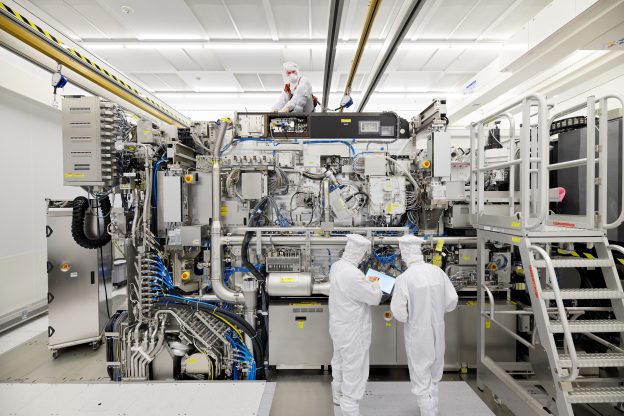Popular Keywords
- About Us
-
Research Report
Research Directory
Semiconductors
LED
Consumer Electronics
Emerging Technologies
- Membership
- Price Trends
- Press Center
- News
- Events
- Contact Us
News
- Home
- News
[News] How Costly is the High-NA EUV? TSMC Reportedly Shocked, Considering Not Using the Equipment in its A16 Node

According to sources cited by a report from Economic Daily News, TSMC’s A16 advanced process node might not necessarily require ASML’s latest advanced chip manufacturing equipment, the High Numerical Aperture Extreme Ultraviolet Lithography (High-NA EUV), due to its expensive price.
Per a report from Bloomberg, during a technical symposium in Amsterdam on May 14th, TSMC’s Senior Vice President of Business Development and Co-Chief Operating Officer, Dr. Kevin Zhang, remarked that while he appreciates the capabilities of High-NA EUV, he finds its price tag to be unlikeable.
As per the same report from Bloomberg, ASML’s new machine is capable of imprinting semiconductors with lines measuring just 8 nanometers in thickness — 1.7 times smaller than the previous generation.
In terms of pricing, this EUV machine is reportedly priced at EUR 350 million (roughly USD 380 million), with a weight equivalent to two Airbus A320 passenger planes, according to Bloomberg.
Dr. Kevin Zhang stated that TSMC’s planned A16 node (scheduled for volume production slightly later in 2026) may not necessarily require the use of ASML’s High NA EUV equipment. Instead, TSMC could continue to rely on its existing, older EUV equipment. “I think at this point, our existing EUV capability should be able to support that,” he expressed.
He further mentioned that the decision to adopt the new ASML technology would depend on where it offers the most economic benefits and the technical balance they can achieve. He declined to disclose when TSMC might purchase High-NA EUV from ASML.
On the other hand, Intel has confirmed in mid-April that it has received and assembled the industry’s first High-NA EUV lithography system, which is expected to be able to print features up to 1.7x smaller than existing EUV tools. This will enable 2D feature scaling, resulting in up to 2.9x more density.
Currently, both TSMC and Samsung utilize EUV equipment for manufacturing, covering TSMC’s 7nm, 5nm, and 3nm processes and Samsung’s EUV Line (7nm, 5nm, and 4nm) located in Hwaseong, Korea, along with the 3nm GAA process.
Read more
- [News] Intel Secures First Batch of High-NA EUV Equipment from ASML, Ahead of Samsung and SK Hynix
- [News] EUV as a Strategic Asset in the Most Advanced Processes: Progress in Intel/TSMC/Samsung’s Adoptions
(Photo credit: ASML)
Please note that this article cites information from Economic Daily News and Bloomberg.
Subject
Related Articles
Recent Posts
- [News] How Costly is the High-NA EUV? TSMC Reportedly Shocked, Considering Not Using the Equipment in its A16 Node
- [COMPUTEX 2024] AI Will Lead Startups to Renewed Glory as the Unicorn Boom Fades
- [News] Vision Pro Reportedly Set for First Sale Outside US, Potential Launch Countries Revealed!
- [News] GPU Shortage Issue for AI Eased, Followed by a New Problem
- [News] Samsung and SK Hynix Urgently Reallocate 20% of DRAM Production Capacity to Support Rising HBM demand
Recent Comments
Archives
- May 2024
- April 2024
- March 2024
- February 2024
- January 2024
- December 2023
- November 2023
- October 2023
- September 2023
- August 2023
- July 2023
- June 2023
- May 2023
- April 2023
- March 2023
- February 2023
- January 2023
- December 2022
- November 2022
- October 2022
- September 2022
- August 2022
- July 2022
- June 2022
- May 2022
- April 2022
- March 2022
- February 2022
- January 2022
- December 2021
- November 2021
- October 2021
- September 2021
- August 2021
- July 2021
- June 2021
- May 2021
- April 2021
- March 2021
- February 2021
- January 2021
Categories
- 5G Technologies
- AR / VR
- Artificial Intelligence
- Automotive Technologies
- Broadband & Home Network
- Cloud / Edge Computing
- Consumer Electronics
- Display
- Display Supply Chain
- Display Technologies
- DRAM
- Emerging Technologies
- Energy
- IC Design
- IC Manufacturing, Package&Test
- Industry 4.0
- IoT
- IR LED / VCSEL / LiDAR Laser
- LCD
- LED
- LED Backlight
- LED Demand / Supply Data Base
- LED Display
- LED Lighting
- Lithium Battery and Energy Storage
- Micro LED / Mini LED
- Monitors / AIO
- NAND Flash
- Notebook Computers
- OLED
- Others
- Panel Industry
- Semiconductors
- server
- Smartphones
- Solar PV
- Tablets
- Telecommunications
- TVs
- Upstream Components
- Wafer Foundries
- Wearable Devices
- 未分類




